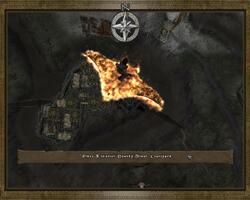The majority of the action takes places in the third-person dragon flight view, which occurs when the map location is clicked. In this portion the players control their beast in as it attacks enemy forces, allowing for explosive fireballs and bullet-time dodging. The dragon can also “visit” the front lines and allow the player to micromanage his or her troops. The dragons are some of the most powerful units in the game, and should they die the player must wait some amount of time before another respawns. Even armed with several explosive weapons, the beasts can be taken down somewhat easily if the player isn’t utlizing them well.
This portion of the game relies on lush, vibrant visuals to portray all manner of lighting battle units and characters set against almost Martian landscapes. Here, the steampunk style mixes a bit of manga into it to make the dragons look more reptilian and the environment somewhat glossy.
The dragons can be used to “zoom into” a set of troops and units, for a traditional overhead RTS control method. This allows for group actions aimed at defeating the opposing faction. Players are asked to set up turrets and factories, with mining for resources taking place to feed the forces. It’s very traditional real-time strategy gaming. After the troops are set, the dragon takes off and can attack the other factions back in third person mode. It’s seemless, and looked natural.
...
Dragon Commander seems like a complicated game, though underneath its excess is actually a fairly traditional kingdom-building RTS along the lines of RISK. The way that the different portions of kingdom-building are presented with enough variety from one other is going to be interesting to see which take precedence. I suspect that different players will lean more heavily to one mode or another, depending on their level of comfort within the genre mix.














